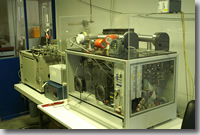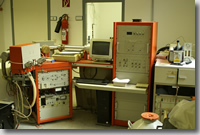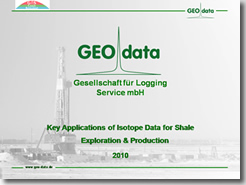

Address
GEO-data, Dienstleistungsgesellschaft für Geologie, Hydrogeologie und Umweltanalytik mbH
Carl-Zeiss-Str. 2
30827 Garbsen
Phone
Telephone: 05131/7099-0
Telefax: 05131/7099-60
Business hours
Mo. - Fr. 07:30 bis 16:30 Uhr
Unconventional Gas Services
|
For the exploration and the later exploitation of shale gas plays and other unconventional hydrocarbon reservoirs the understanding of the source rock and their geochemistry is of major importance. Geochemistry is the main source to be able to detect unconventional plays, as well as of major importance for the evaluation of the quality and the future development of these plays.
In shale gas plays, the source is the reservoir, and gases reside in place and do not migrate significantly, meaning, for example, that maturity-related properties in gases are directly related to the maturity of the surrounding rock. Although shale gases are called “unconventional” this term only applies to their occurrence because shale gases: |
|
- are not focused in well defined reservoir sands but occur disseminated in the rock fabric.
- do not flow to the well bore, but have to be liberated from the rock through fracing.
 |
However, in regard to gas formation, the rules of gas formation are the same as those of conventional gas formation, i.e. the temperature-driven transformation of organic matter to oil and gas. These special conditions of occurrence make gas geochemical techniques, in particular gas isotope techniques a crucial technology for gas exploration and production. |
Hydrocarbon projects, especially shale gas projects have to be viewed from the perspective of a special Life Cycle Management Process. This process consists of five phases:
- Phase 1 – Regional Hydrocarbon Assessment
- Phase 2 – Pilot Program
- Phase 3 – Early Development
- Phase 4 – “Factory Mode” Development
- Phase 5 – Maintenance and Remediation
Generally, the local geology is well known and possible target rocks are known and geological mapped. Even though the rocks are known, the possible potential of in-situ gas content and further petrophysical and petrochemical parameters are unknown or at least less known. To classify the potential it is imperative to carry out core data collection and analyses beside other analytics. Those are needed during the pilot program phase and early development phase. |
 |
Core data are collected to determine the following critical parameters:
- Bulk chemical and physical properties of rock
- Proportion of in-organic versus organic content (TOC/TIC)
- Gas storage mechanism (sorbed versus free gas)
- Gas content (desorbed gas content and composition)
- Gas-in-Place
- Thermal maturity
To determine the above-mentioned parameters the following on-site (field-) services and laboratory services should be taken into account. Special emphasize has to be laid on gas sampling and isotopic compound analytics as well as desorption directly after coring, because the only chance to gather those data more or less undisturbed and without major influences is during the drilling/coring operations, when the rock is drilled and initially releases its gas content. All later logging and wireline sampling will not have the same quality as the “first” fingerprints gathered during drilling.

